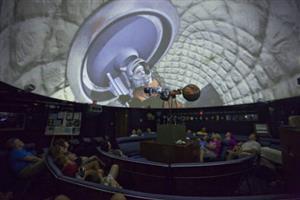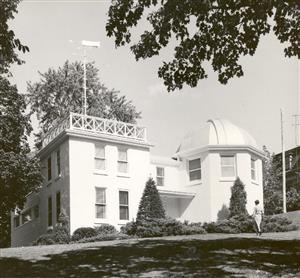- School District U-46
- Our Impact
- Planetarium
Planetarium
-
U-46 Educational Foundation helps inspire future scientists and star-lovers
 Elgin School District U-46 Planetarium teacher Peggy Hernandez, working in the historic building on Watch Street during her first year in the position, opened the door to an older gentleman. He was in town visiting relatives and wanted to stop by a place he visited often as a child. After graduating from U-46, the man went on to study astronomy and become a college professor in North Carolina.
Elgin School District U-46 Planetarium teacher Peggy Hernandez, working in the historic building on Watch Street during her first year in the position, opened the door to an older gentleman. He was in town visiting relatives and wanted to stop by a place he visited often as a child. After graduating from U-46, the man went on to study astronomy and become a college professor in North Carolina.Hernandez says such visits are not rare. Adults stop by, sometimes decades after they last visited the planetarium, and they remember what they learned back then – even what seat they sat in when they learned it.
Since it opened in 1963, the U-46 Planetarium has served more than 1 million children.
“One little girl last week stood up to leave and came over and hugged me by the waist,” Hernandez said. “She said ‘This is so awesome. I love this place. I want to be a scientist.’ When they’re walking out, I often hear that. They say to their friends, ‘This is so cool. I can’t wait until we get back here.’”
The planetarium has been one of the greatest beneficiaries of the U-46 Educational Foundation, receiving $20,000 in grants since the foundation’s inception in 2008. The foundation has made full-dome planetarium shows possible, bridging an otherwise insurmountable gap between the program budget and the cost of the shows.
Videos need to be specially designed to be viewed on the curved dome of the planetarium, but having a projector that can display such videos and the programs themselves creates an immersive experience for visitors.
Thanks to the U-46 Educational Foundation, students can learn about the dawn of the space age and the science behind the movement of the sun, earth and moon on a massive screen.
What’s more, the U-46 Educational Foundation made it possible for first graders to leave the “The Moon” program with their own notebooks to track the patterns they see in the moon and their view of the constellations at home. With new information in mind and notebooks in hand, these students can become scientists themselves, making observations and drawings that astronomers made centuries ago.
 While most of these students won’t become astronomers themselves, Hernandez knows many will get jobs in science-related fields. The economy will demand it. And even those who don’t may find themselves looking up at the sky as adults, thinking back to their time in U-46 and the lessons they learned in the planetarium – some, courtesy of the Educational Foundation.
While most of these students won’t become astronomers themselves, Hernandez knows many will get jobs in science-related fields. The economy will demand it. And even those who don’t may find themselves looking up at the sky as adults, thinking back to their time in U-46 and the lessons they learned in the planetarium – some, courtesy of the Educational Foundation.“It’s just neat to make that connection and experience that wonderment and know that it’s permanent,” Hernandez said. “This isn’t just a workbook or a little extra activity that you do in the classroom. This is something that kids can really, really remember.”
The U-46 Planetarium is open to students in and outside of U-46, community groups and, through occasional sky shows, the public. For more information about programs and upcoming events, visit the planetarium website.

